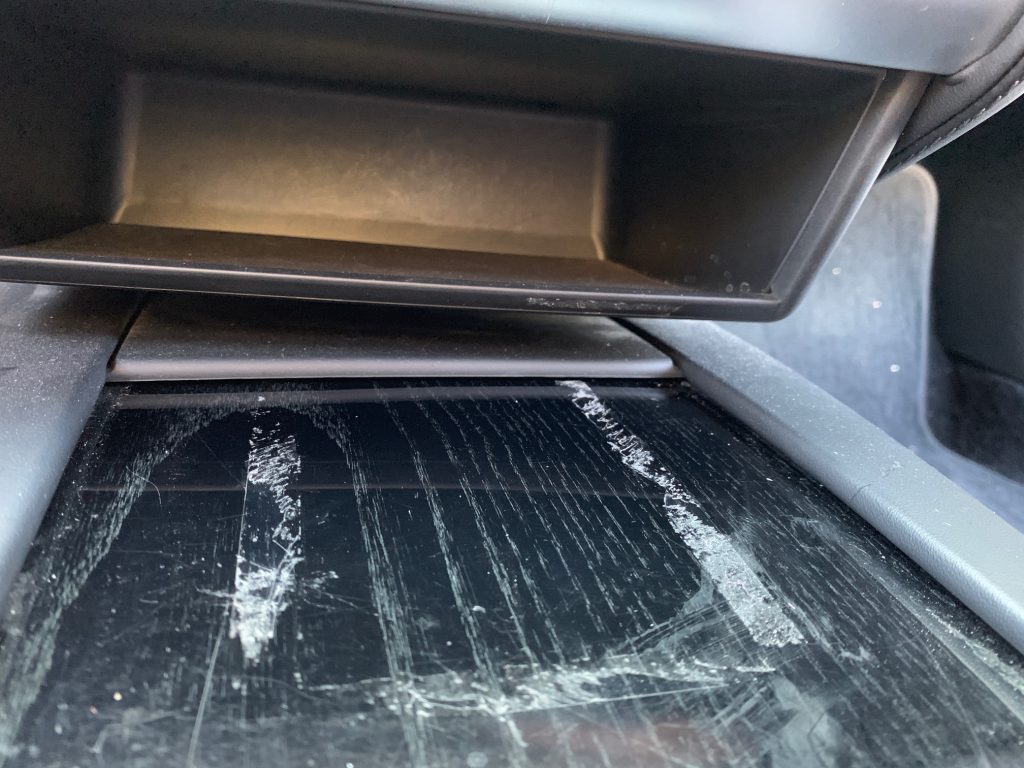We may receive a commission when you use our affiliate links. However, this does not impact our recommendations.

Even though the sliding storage door looks like wood, I believe it’s plastic with an imprinted wood grain.
Like many others in California, my son owns a Tesla. It has a storage compartment with a sliding door between the front seats. A year or so ago my son taped some paper with information he needed to the top of the door. Recently, when he went to remove the Scotch Tape, he was only able to peel off the plastic backing. He wasn’t able to remove most of the adhesive.
So, Papa to the rescue. (I was visiting grandchildren.)
Unfortunately, as I’ve written many times, the Los Angeles area has eliminated the sale of many solvents, which I could have used to remove the adhesive. So I was limited to a few solvents my son still had from years before the restrictions were introduced. He still had an old can of lacquer thinner, which I knew would remove the adhesive easily. The stores also still sold acetone, an exempt solvent and a primary active ingredient in lacquer thinner. So I could use acetone. But I didn’t want to use either because I was pretty sure the top of the door was plastic, and both of these solvents would damage plastic.
I could have used naphtha, which is stronger than paint thinner, but naphtha isn’t available any longer in southern California.
Paint thinner is still available, but as I’ve explained before, the paint thinner sold in LA contains a lot of acetone to get the thinner to comply with the strict VOC laws. The paint thinner would probably damage the plastic just as acetone would.
Turpentine is not as strong as naphtha, but it is stronger than traditional paint thinner, and my son had an old can of turpentine. So I decided to try it; I knew it wouldn’t damage the plastic.
So the end of the story, as you probably suspect, is that I was able to get the turpentine to work well enough to remove the adhesive, though it took some serious rubbing. I’m not sure what I would have tried if there hadn’t been that old can of turpentine. The most likely solution that comes to mind is to try a blow dryer. It shouldn’t get hot enough to damage the plastic, but it might soften the adhesive enough to make it possible to rub off. Though this would probably create a mess.
Solvents are so useful for solving many problems. I think it’s a shame that their sale is being restricted.
Further Reading: How to Remove Crayon and Candle Wax
Here are some supplies and tools we find essential in our everyday work around the shop. We may receive a commission from sales referred by our links; however, we have carefully selected these products for their usefulness and quality.










Mr. Flexner,
3M makes a citrus base adhesive remover that I have found to be more effective at removing tape residue than any of the solvents that you mentioned. It contains no petroleum based solvents and is available in 5 ounce aerosol cans from Amazon (and is far superior to Goo Gone). I have used it to remove VHB (very high bond) tape, an extremely tenacious adhesive which is used to adhere automobile badges, with no damage to the paint. In your example above, I would spray as all amount on a rag (outside toe car) and rub the residue with the dampened rag.
Gasoline often is an excellent tape adhesive remover – it wipes it off immediately.
The other thing I find very useful is lighter fluid. It will dissolve many adhesive types but rarely seems to leave any residual adhesibe ot injury to materials.
Lighter fluid is Naptha
SidneyM: Thanks for the tip about using oil.
Brian: I’m sorry you seem to disagree with my views on solvents.
LongLeaf: I would think a citrus solvent would work with lots of rubbing or with Sidney’s technique. Be careful there’s no acetone in the solvent.
Another method is to soak the adhesive covered area in an oil (WD-40, 3-in-One, cooking oil, etc.) overnight. A tissue spread over the area also helps hold the oil in the desired spot. The next day, the adhesive is very soft and can be wiped off with another tissue. Then wash the area with soapy water damp rag to remove any oil residue. Takes time, but less chances of damaging the plastic and very environmentally friendly. I use this on many adhesives including glass bottles, magazine labels, etc. If the label is coated, you may want to sand the label lightly to allow the oil to soak into the paper.
@LongLeaf: It wouldn’t be effective at all … because the real purpose here was to rant against the banning of deleterious solvents.
You will note how the LA air shows little or no improvement. These consumer punishments will accomplish little as long as there are a “gazillion” auto commuters every day
How effective would one of the citrus based solvents be?
Thanks
Have had great success with Goo Gone which is citrus based on various PSAs and no substrate damage